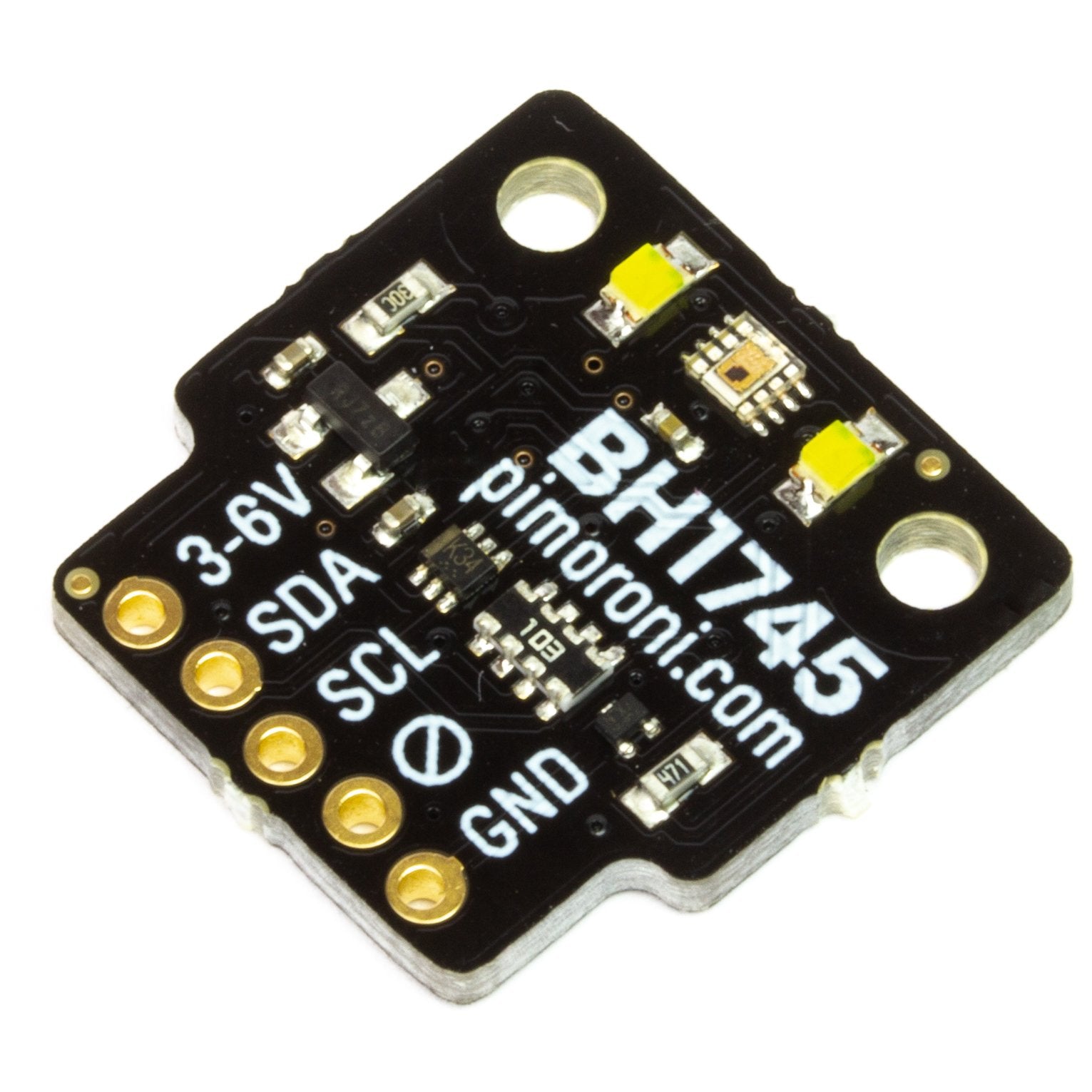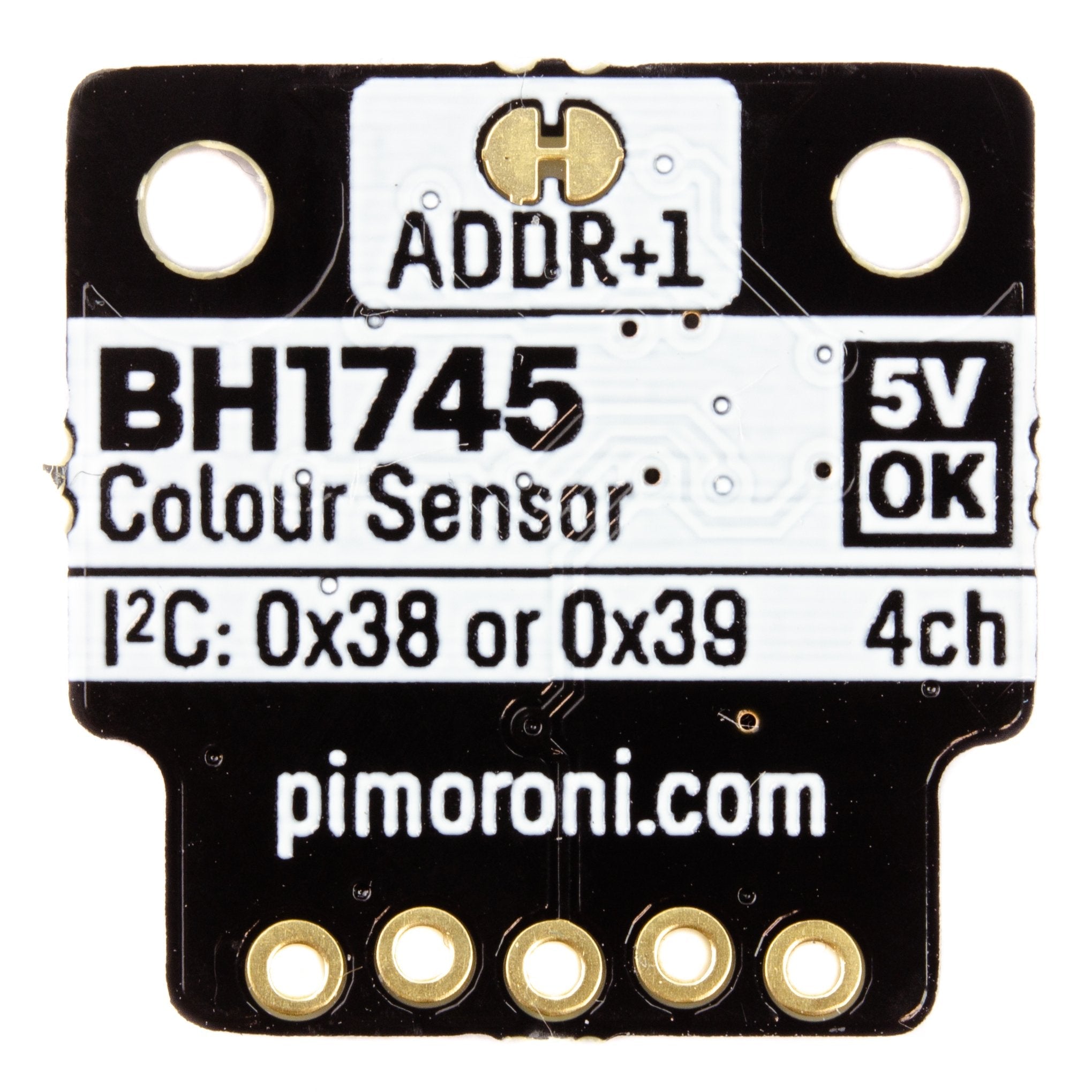Ein wirklich ausgeklügeltes und genaues Farb- und Luminanzsensor-Breakout, das mit Raspberry Pi und Arduino kompatibel ist. Neben der Erkennung von RGB-Farben und der Lichtstärke verfügt er über zusätzliche Funktionen wie die Unterdrückung von 50/60 Hz-Lichtrauschen, einen großen Erfassungsbereich und zwei Beleuchtungs-LEDs.
Dieser Sensortyp ist derselbe, der auch in Handys, Tablets und Laptops zu finden ist, wo er die Temperatur des Umgebungslichts erkennt und die Farbtemperatur des Displays entsprechend anpasst.
Das BH1745 Luminanz- und Farbsensor-Breakout hat eine I2C-Schnittstelle und ist mit 3,3V oder 5V kompatibel. Wie unsere anderen Pimoroni-Ausbrüche Wir haben ihn so konzipiert, dass Sie ein Stück rechtwinkligen Stecker anlöten und ihn dann direkt auf die unteren linken 5 Pins des GPIO-Steckers Ihres Raspberry Pi stecken können (Pins 1, 3, 5, 6, 9).
Es ist auch kompatibel mit unserer neuen, schicken Breakout Garten Die Verwendung von Breakouts ist so einfach, wie sie in einen der sechs Slots zu stecken und mit dem Wachsen des Projekts, dem Erstellen und Codieren zu beginnen.
Eigenschaften
- BH1745 Leuchtdichte- und Farbsensor
- Zwei weiße Beleuchtungs-LEDs
- Rot-, Grün-, Blau- und Leuchtdichtemessungen
- 0,005 bis 40.000 Lux Erfassungsbereich
- 50/60Hz Lichtgeräuschunterdrückung
- IR-Sperrfilter
- 16-Bit-Datenausgabe
- 3,3V oder 5V kompatibel
- I2C-Schnittstelle, mit Adressauswahl über ADDR cuttable trace (0x38 oder 0x39)
- Schutz vor Verpolung
- Raspberry Pi-kompatible Pinbelegung (Pins 1, 3, 5, 7, 9)
- Kompatibel mit Raspberry Pi 3B+, 3, 2, B+, A+, Zero, und Zero W
- Python-Bibliothek
- Datenblatt
Der Bausatz enthält
- BH1745 Leuchtdichte- und Farbsensor-Breakout
- 1x5 Stiftleiste
- 1x5 rechtwinklige Buchsenleiste
Software
Wir haben eine Reihe von Python-Bibliothek mit dem Sie Daten von Ihrem BH1745 Luminanz- und Farbsensor-Breakout auslesen können, sowie ein einfaches Einzeleinbau-Programm, um alles zu installieren.
Unsere Software unterstützt Raspbian Wheezy nicht.
Anmerkungen
- Die Leiterbahn zwischen den Lötpads (markiert mit ADDR) kann durchtrennt werden (vorsichtig mit einem Bastelmesser), um die I2C-Adresse von der Standardeinstellung 0x38 auf 0x39 zu ändern, was bedeutet, dass Sie bis zu zwei Sensoren an demselben Raspberry Pi oder Arduino verwenden können. Wenn sie durchgeschnitten sind, können die Pads durch Löten wieder überbrückt werden, um die Adresse auf 0x38 zurückzusetzen.
- Abmessungen: 19x19x3mm
English Description
A really sophisticated and accurate colour and luminance sensor breakout that's Raspberry Pi and Arduino-compatible. As well as detecting RGB colour and light level, it has added bells and whistles like 50/60Hz light noise rejection, a wide detection range, and two illumination LEDs.
This type of sensor is the same as you'd find in phones, tablets, and laptops where they're used to detect ambient light temperature and adjust the colour temperature of the display accordingly.
The BH1745 Luminance and Colour Sensor Breakout has an I2C interface and is 3.3V or 5V compatible. Like our other Pimoroni breakouts, we've designed it so that you can solder a piece of right-angle header onto it and then pop it straight onto the bottom left 5 pins on your Raspberry Pi's GPIO header (pins 1, 3, 5, 6, 9).
It's also compatible with our fancy new Breakout Garden, where using breakouts is as easy just popping it into one of the six slots and starting to grow your project, create, and code.
Features
- BH1745 luminance and colour sensor
- Two white illumination LEDs
- Red, green, blue, and luminance measurements
- 0.005 to 40,000 lux detection range
- 50/60Hz light noise rejection
- IR cut filter
- 16 bit data output
- 3.3V or 5V compatible
- I2C interface, with address select via ADDR cuttable trace (0x38 or 0x39)
- Reverse polarity protection
- Raspberry Pi-compatible pinout (pins 1, 3, 5, 7, 9)
- Compatible with Raspberry Pi 3B+, 3, 2, B+, A+, Zero, and Zero W
- Python library
- Datasheet
Kit includes
- BH1745 Luminance and Colour Sensor Breakout
- 1x5 male header
- 1x5 female right angle header
Software
We've put together a Python library that you can use to read data from your BH1745 Luminance and Colour Sensor Breakout, and an easy one-line installer to install everything.
Our software does not support Raspbian Wheezy.
Notes
- The trace between the solder pads (marked ADDR) can be cut (carefully with a craft knife) to change the I2C address from the default of 0x38 to 0x39, meaning that you can use up to two sensors on the same Raspberry Pi or Arduino. If cut, the pads can be bridged again by soldering to reset the address to 0x38.
- Dimensions: 19x19x3mm
Sicherheitsangaben
- Lesen Sie die Bedienungsanleitung sorgfältig durch, bevor Sie das Produkt verwenden.
- Stellen Sie sicher, dass alle Montage- und Installationsanweisungen des Herstellers sorgfältig befolgt werden.
- Verwenden Sie das Produkt nur für den vorgesehenen Zweck.
- Die unsachgemäße Nutzung dieses Produkts kann zu schweren Verletzungen oder Sachschäden führen.
- Nicht für Kinder unter 10 Jahren geeignet.
- Bei unsachgemäßer Verwendung besteht eine Verletzungsgefahr.
- Dieses Produkt entspricht den geltenden Sicherheitsanforderungen der Europäischen Union.
- Dieses Produkt wurde gemäß der GPSR geprüft, die sicherstellt, dass alle relevanten Sicherheitsanforderungen für Konsumgüter eingehalten werden.
Nachverfolgbarkeitsinformationen
Jedes Produkt verfügt über eines oder mehrere der folgenden Merkmale:
- Ein CE-Kennzeichen, das die Einhaltung der Sicherheits-, Gesundheits- und Umweltschutzanforderungen der Europäischen Union anzeigt.
- Eine eindeutige Serien- oder Chargennummer, um die Nachverfolgbarkeit zu gewährleisten und bei Bedarf Rückrufaktionen zu unterstützen.
- Hersteller- und Importeurangaben für den Kundensupport und Sicherheitsanfragen.
Überwachung und Berichterstattung von Vorfällen
Für den unwahrscheinlichen Fall eines Produktproblems haben wir Verfahren implementiert, um:
- Kundenbeschwerden zeitnah bearbeiten.
- Schwerwiegende Vorfälle über das EU Safety Gate/RAPEX-System melden.
- Mit den Marktüberwachungsbehörden zusammenarbeiten, um die öffentliche Sicherheit zu gewährleisten.
Kontakt:
- Email: support [@] pi3g.com
- Telefon: 0341 / 392 858 40
Dieses Produkt ist vollständig mit allen geltenden EU-Vorschriften konform, um die Sicherheit unserer geschätzten Kunden zu gewährleisten.



